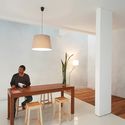
-
Architects: Parametr Indonesia
- Area: 105 m²
- Year: 2017
-
Photographs:Ario Andito
-
Manufacturers: Dulux, Onduline, Toto

Text description provided by the architects. Located at Jagakarsa sub district, South Jakarta city, this house is situated in a typical housing of a developer with similar type of room and facade and coincides with neighboring houses. The homeowner wishes to add some space in his house holding 7x15m land area.
































